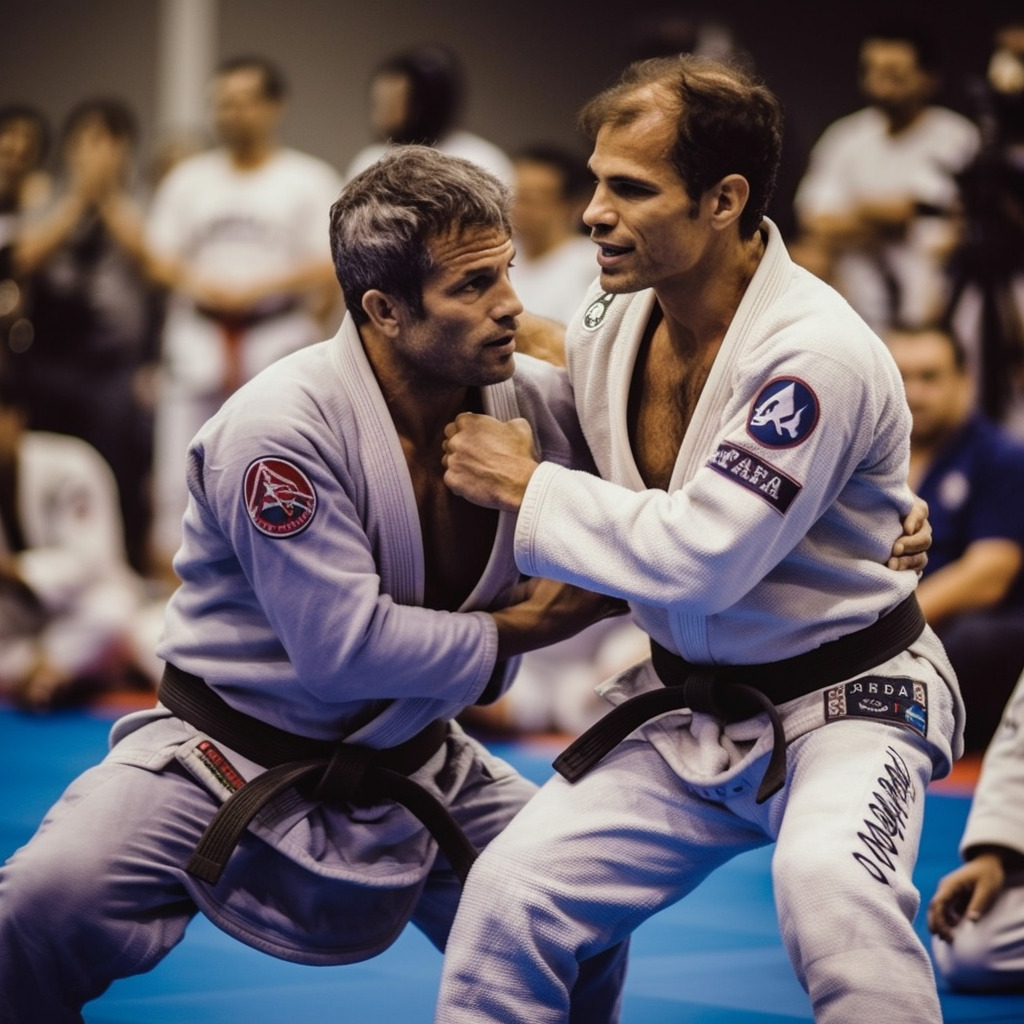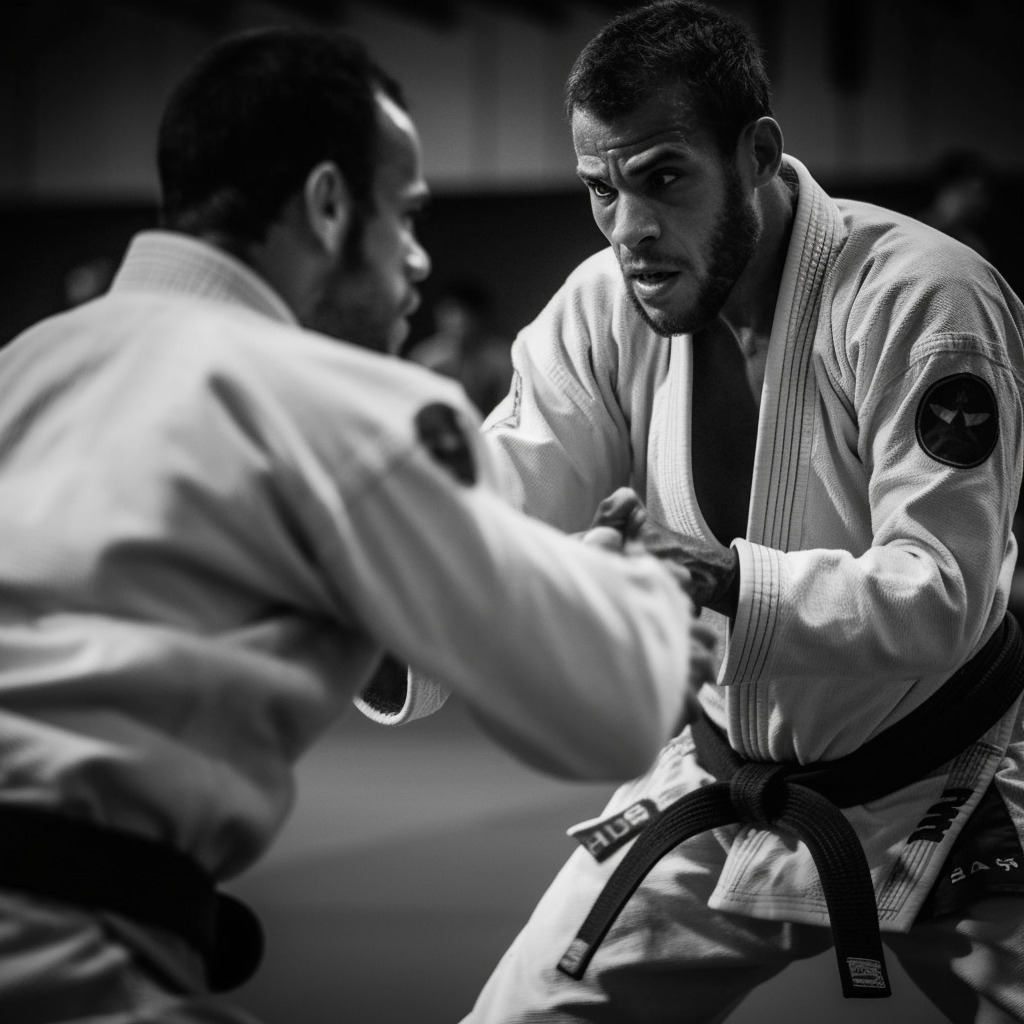Brasilianische Jiu-Jitsu, abgekürzt „BJJ“ oder auf Portugiesisch „jiu-jitsu brasileiro“, stellt eine clever Abwandlung sowie Weiterentwicklung der japanischen Kampfkünste Judo sowie Jiu-Jitsu dar. Das Augenmerk dieser Kampfkunst richtet sich auf den Bodenkampf. Vereinzelt werden jedoch auch Wurftechniken aus dem Stand, so wie sie im Judo und Jiu-Jitsu präsent sind, gelehrt.
In 30 Sekunden das Wichtigste:
- Im Brazilian Jiu Jitsu existieren fünf Distanzen. Bodenkampf stellt die fünfte und zugleich schwerste Distanz dar.
- Der Gi oder auch ein Kimono, wie er im Judo und Jiu Jitsu getragen wird, gehört zu der traditionellen Kleidung der Trainierenden.
- Aufgrund der enthaltenden Hebeltechniken im Brazilian Jiu Jitsu, eignet sich die Kampfsportart ideal zur Selbstverteidigung.
- Dies ist ein Buch
- Walder, Marc (Autor)
Was ist Brazilian Jiu Jitsu?
Brazilian Jiu-Jitsu (BJJ) ist eine Kampfsportart, die sich aus dem traditionellen Jiu-Jitsu sowie dem Judo entwickelt hat. Es wurde im 20. Jahrhundert von der Gracie-Familie in Brasilien populär gemacht.
Die Techniken und Philosophie des BJJ betonen Bodenkämpfe und den Grundsatz, dass ein kleinerer, schwächerer Kämpfer einen größeren, stärkeren Angreifer erfolgreich abwehren kann, indem er Hebelwirkung und spezielle Techniken, wie Würfe, Armhebel, Beinhebel und Würgetechniken nutzt.
BJJ ist sowohl eine Sportart als auch eine Methode zur Selbstverteidigung. Es hat sich auch als effektive Disziplin in gemischten Kampfsportarten, wie MMA, erwiesen. Es gibt sowohl Gi- (mit traditioneller Kampfsportkleidung) als auch No-Gi-Varianten (in Shorts und T-Shirt) des Brazilian Jiu-Jitsu.
Wie das brasilianische Jiu-Jitsu entstand
Die Gründer: BJJ stellt die südamerikanische Abwandlung des Kōdōkan Jūdō dar. Carlos und Hélio Gracie sind Brüder und haben diesen beliebten Kampfsport entwickelt.
- Der Erstere trainierte Judo beim Judomeister namens Mitsuo Maeda, welcher ein eifriger Schüler von Kanō Jigorō war. Darüber hinaus gab er seine Kenntnisse an seinen jüngeren Bruder Hélio weiter. Da dieser ein wenig schmächtig war, konnte er aufgrund seiner physischen Beschaffenheit zahlreiche traditionelle Judotechniken nicht ausführen.
- Deshalb wandelte er die Hebelwirkung und Mechanik bei einer Vielzahl der Techniken ab. Auf diese Weise machte er diese nicht nur effektiver, sondern auch für physisch schwächere ausführbar.
In der Literatur ist das Jahr 1914 als Entstehungsjahr des Brazilian Jiu-Jitsu festgehalten. Wie der Name bereits vermuten lässt, diente Brasilien als Ursprungsland dieser faszinierenden Kampfkunst. Die Namensbedeutung stammt aus dem japanischen Judo, was übersetzt sanfter Weg bedeutet. Jiu-Jitsu hingegen symbolisiert eine nachgebende Kunst.
Die beiden Brüder gaben ihr erworbenes Können an ihre eigenen Kinder weiter. Somit erschufen sie die nächste Generation von Kampfsportlern und Lehrern, welche dazu in der Lage waren, das Brazilian Jiu Jitsu weiter. Rorion Gracie war einer der Söhne von Hélio Gracie, der in den siebziger Jahren in die USA auswanderte, um auf diesem Kontinent seine Karriere auszubauen. In seiner Garage gab er sein Wissen an interessierte Kämpfer weiter. So nach und nach stieg das Interesse der Bewohner in den USA für diese Kampfkunst. Deshalb stellen die siebziger Jahre einen prägenden Einschnitt in der Verbreitung und Entwicklung des BJJ dar.
Besonderheiten des Brazilian Jiu Jitsu
Im Brazilian Jiu Jitsu existiert kein Waffenkampf. Der Schwerpunkt liegt auf dem Bodenkampf und den damit verbundenen Techniken. Den Gracie Brüdern ist das Vereinen unterschiedlicher Elemente hervorragend gelungen. Sie haben effektiv Würfe, Hebel, Grappling, Bodenkampf und Würgetechniken miteinander kombiniert. In der Kampfkunst existieren fünf Distanzen.
Der Bodenkampf
Bodenkampf stellt die fünfte und zugleich schwerste Distanz dar. Personen, die eine Kampfkunst oder einen Kampfsport ausüben und Erfahrung im Bodenkampf gesammelt haben, wissen sehr wohl, wie schwer es ist, aus dieser Lage wieder auf die Beine zu kommen. Auf dem Boden fällt es den meisten Kämpfern deutlich schwerer, ihren Gegner zu bezwingen. Eine falsche Bewegung reicht vollkommen aus, um den Kampf zu verlieren.
Aus Rückenlage befreien
Darüber hinaus lehrt das BJJ seine Schüler, sich erfolgreich aus einer Rückenlage zu befreien. Kämpfer zielen stets darauf ab, ihren Gegner in die Rückenlage zu bringen, da sich die Befreiung aus dieser Lage als äußerst schwierig gestaltet. Wenn der Gegner dann auch noch physisch überlegen ist, erscheint es nahezu unmöglich, aus der Rückenposition in die Bauchlage zu kommen.
In solchen Fällen haben sich die Techniken des Brazilian Jiu Jitsu wie beispielsweise die Triangle als hilfreich erwiesen. Schmächtige und schwächere Personen können damit einen stärkeren Gegner überlisten und sich aus der Rückenlage befreien.
Hebel- und Würgegriffe
Kämpfer können sich dank der effektiven Bodentechniken aus dem Judo sowie den praktischen Hebel- und Würgegriffen aus dem Jiu-Jitsu erfolgreich im Bodenkampf behaupten. Die Sportart setzt sich aus Techniken, welche die Kraft des Gegners ausnutzen, um sich effektiv zu verteidigen oder einen Kampf zu gewinnen, zusammen.
Das Brazilian Jiu Jitsu ist in dieser Hinsicht anderen Kampfkünsten überlegen, denn diese fokussieren sich nicht auf den herausfordernden Bodenkampf.

Gürtel & Wettkämpfe im Brazilian Jiu-Jitsu
Das Brazilian Jiu-Jitsu hat sich seit seiner Verbreitung zu einer beliebten Wettkampfsportart entwickelt. Dabei messen sich Kämpfer in unterschiedlichen Gewichts- und Anfänger-Fortgeschrittenen-Klassen, die sich zudem nach der Gürtelfarbe der Wettkämpfer einteilen. Das Graduierungssystem des BJJ weist im Vergleich zu den herkömmlichen japanischen Gürtelsystemen bedeutende Unterschiede auf.
- Die Abfolge vom Anfänger bis zum Meister beginnt bei der Farbe Weiß. Sie geht weiter mit Blau, Lila, Braun und endet bei Schwarz. Darüber hinaus gibt es einen Rotgurt, der über dem Schwarzgurt steht. Allerdings ist die Anzahl der weltweiten Rotgurtträger äußerst gering und diese Graduierung spielt momentan im BJJ eine Nebenrolle.
- In der Regel vergibt ein Lehrer an seine Schüler die nächsthöchste Graduierung. Im BJJ spielt die Dauer der Trainierenden eine untergeordnete Rolle. Eine Gürtelverleihung, die sich auch Beltpromotion nennt, dient als Grundlage des verzeichneten Erfolges der Schüler. Die Kämpfer erzielen diesen im Training und bei Wettkämpfen. Eine große Anzahl an Schulen vergibt auch bis zu vier Streifen je Gurt. Diese stellen eine weitere Feingliederung ihres Könnens dar.
Die unterschiedlichen Wettkämpfe gliedern sich in World Jiu Jitsu Championship (Weltmeisterschaften), World Master Championship, Pan American Championship und Europameisterschaften.
Verbreitung des Brazilian Jiu Jitsu
Das Brazilian Jiu Jitsu erfreut sich einer steigenden Beliebtheit unter den Kampfkunst-Anhängern. Es fand seinen Verbreitungsweg von Brasilien in die USA. Dort nahm sowohl der Bekanntheitsgrad als auch die Beliebtheit rapide zu. Im Vergleich zu Deutschland sind dort wesentlich mehr BJJ-Schulen präsent.
Allerdings steigt auch in Deutschland und Europa der Bekanntheits- und Beliebtheitsgrad kontinuierlich an. Das liegt unter anderem am intensiven Bodentraining, welches in keiner anderen Kampfkunst so stark vertreten ist. Der Wettkampf- und Selbstverteidigungscharakter des Brazilian Jiu Jitsu machen diese Kampfkunst zu einem vielseitigen Sport. In Deutschland existiert auch ein Verband für das Brasilianische Jiu Jitus.
Traditionelle Kleidung im BJJ
Der Gi oder auch ein Kimono, wie er im Judo und Jiu Jitsu getragen wird, gehört zur Kleidung der Trainierenden. Darüber hinaus tragen sie unter ihrem Gi ein T-Shirt. Der Gürtel darf selbstverständlich nicht fehlen. Männer sollten auf jeden Fall einen Tiefschutz tragen. Für das Üben von Kämpfen lohnt sich auch der Einsatz eines Mundschutzes. Diejenigen, die über einen längeren Zeitraum das „Rollen“ bzw. „Kämpfen“ trainieren tun sich mit Knieschonern einen großen gefallen.
BJJ-Anhänger, die diese Kampfkunst länger ausüben, nutzen wie Judokämpfer Bandagen für ihre Hände. Dadurch schonen sie ihre Hände und Finger. Sie gehen so vor, um dauerhafte Schäden durch die Belastung zu vermeiden. Durch die Arbeit am Computer sind die Hände der Mehrzahl der Trainierenden anfälliger für Verletzungen. Bandagen können der Verletzungsgefahr effektiv entgegenwirken.
Bei Wettkämpfen tragen die Trainierenden einen Helm bzw. Kopfschutz. Ansonsten trainieren die Kampfkunst-Liebhaber definitiv barfuß.
Eignet sich Brazilian Jiu Jitsu zur Selbstverteidigung?
Diese Frage lässt sich eindeutig mit einem klaren „Ja“ beantworten. Da die Sportart sowohl Angriff- als auch Verteidigungstechniken beinhaltet. Darüber hinaus sollten die Praktizierenden jedoch wissen, dass sie im Falle eines Angriffs improvisieren müssen und die gelernten Techniken nicht eins zu eins anwenden können.
- Allerdings werden sie keine klassischen Opfer eines Angriffs, sondern aufgrund des Trainings definitiv reagieren können und nicht wie ein hilfloses Opfer um Hilfe schreien. Solch eine Reaktion lähmt den Gegner. Angreifer können gute Kämpfer sein, jedoch hat sie in diesem Moment die Überraschung ergriffen. Dagegen rechnen sie keineswegs mit einer Abwehrreaktion. Für eine kurze Sekunde geraten sie dann in eine Schocksituation. Das ist die beste Sekunde, in der die angegriffene Person reagieren sollte.
- Da das Brazilian Jiu Jitsu Hebeltechniken enthält, können Angegriffene in der Praxis diese anwenden, um den Gegner außer Gefecht zu setzen. Beim Durchziehen des Hebels können sie ihrem Angreifer den Arm brechen. Mit einer Würgetechnik haben sie die Möglichkeit den Angreifer zu erschrecken oder gar bewusstlos zu würgen.
- Personen, die das BJJ zur Selbstverteidigung nutzen, entwickeln einen Verteidigungsreflex. Doch dafür sollten sie mindestens drei Monate drei oder zwei Mal pro Woche in das Training gehen. Vorher stellt sich der Reflex, auf einen Angriff zu reagieren, nicht ein.
- Darüber hinaus entwickeln Personen, die eine Kampfkunst ausüben, eine selbstbewusstere Körperhaltung, Kraft und Kondition, die sie vor einem Angriff schützen kann. Täter sind oft „Hobbypsychologen“, die sich ihre Opfer gezielt aussuchen. In der Regel halten sie sich von Personen, die einen aufrechten Gang mit einem nach vorne gerichtetem Blick haben, fern.
Im Hinblick auf die Selbstverteidigung eignet sich das BJJ vor allem für den Bodenkampf genauso gut wie andere Kampfkünste. Die Hebeltechniken lassen sich auch hervorragend im Stand anwenden. Sollte aber eine Kampfkunst zur reinen Selbstverteidigung gesucht werden, ist ein Selbstverteidigungskurs oder ggf. Krav Maga noch besser geeignet.

FAQ
- Boxsack Basics: Findet den perfekten Boxsack für euer Heimtraining - 23. November 2023
- Mobbing am Arbeitsplatz: Tipps & Hilfestellungen für Betroffene - 15. November 2023
- Wohnung & Haus effektiv vor Einbruch schützen: 10 Tipps & FAQ - 3. November 2023
Update: 2025-07-01 / Affiliate Links / Bilder von der Amazon Product Advertising API

